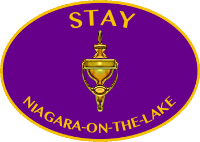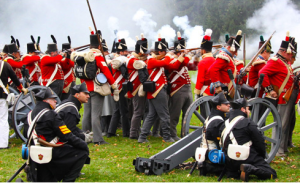
For many Indigenous peoples, the Niagara Region has been a powerful spiritual site since melting glaciers revealed the great lakes of Erie and Ontario and the mighty Niagara River approximately 13,000 years.
A Sacred Place
Considered a sacred place of great power and healing, the Niagara Region was used for religious ceremonies and rituals as well as for hunting and fishing. The Haudenosaunee (Iroquois) believed the Thunderer, a powerful spirit associated with thunder and lightning, resided in the Niagara Region, and that the Falls were created by the Thunderer’s voice.
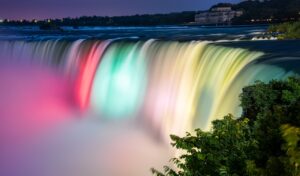
The region was also an important meeting place for Indigenous nations, who gathered here to discuss matters of trade diplomacy and war. It was considered a neutral zone, where conflicts could be resolved peacefully. However, if conflicts broke out between the Huron and Iroquois, warring tribes often brought their women and children to the resident Neutral Nation for safekeeping during such dangerous times.
The Neutral Nation was a highly developed culture with sophisticated agricultural techniques, which included the use of irrigation and terracing to cultivate crops like tobacco. They had extensive trade networks throughout the Great Lakes region and were known for their highly valued pottery as well as their tobacco trade. They also had a complex social and political structure, with distinct clans and a council of leaders who made decisions on behalf of the ten tribes of the Iroquois Nation.
The land along the Niagara River continues to have rich ties to Indigenous history and culture. The Indigenous Niagara Living Museum Tours features animated encounters and engagements with Indigenous peoples, cultural interpreters, historians, food specialists and artisans. Tours explore the geology of the Niagara Escarpment and include Fort George in Niagara-on-the-Lake, the Willowbank School of Restoration and Indigenous Community Love Garden and the Landscape of Nations Commemorative Memorial in Queenston, the Niagara Glen Nature Centre, and many more.
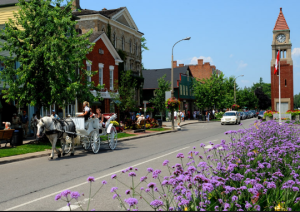
Our Home on Native Land
Sadly, the arrival of European explorers and settlers in the 17th century brought diseases that devastated the population of the Neutral Nation and other tribes, and their way of life was disrupted by the fur trade and conflicts.
In the 18th century, the British established Fort George, a military outpost in Niagara-on-the-Lake. During the War of 1812, Fort George played a crucial role in the defence of Upper Canada against American invasion. It was the site of several battles, including the Battle of Fort George in May 1813, when American forces captured the fort and burned down much of the town.
Following the war, the fort was rebuilt and used as a military base until the mid-19th century. Today, Fort George is a National Historic Site of Canada and a popular tourist attraction. Visitors can explore the fort’s barracks, officers’ quarters and other buildings, as well as view historical demonstrations and re-enactments of military life during the War of 1812. Fort George is open from 10 a.m. to 5 p.m. Saturdays and Sundays until May 19, daily from May 20 to September 3, and Wednesday to Sunday from September 4 to October 31. By the way, entrance fees are waived on July 1, Canada Day!
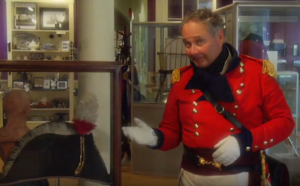
The Niagara-on-the-Lake Museum features 9,000 years of history ranging from Indigenous history to the tourism boom of the 1970s. Its gallery contains such significant artefacts as a powder horn belonging to Chief Joseph Brant, the Indian Department Coatee worn by Daniel Servos during the American Revolutionary War, uniforms from the War of 1812 and much more.
Black Canadian History
Niagara’s role in the Underground Railroad is legendary. Between 1796 and 1949, the Underground Railroad led an estimated 40,000 African American slaves to their ultimate freedom in Canada. Fort Erie, Ontario became a popular crossing for freedom seekers because of its proximity to Buffalo, New York.
Niagara Parks features some of Canada’s most poignant stories of freedom and courage among its extensive collection of displays and monuments honouring Black Canadian history. As you drive, cycle or walk along the 56-kilometre (35-mile) Niagara River Recreation Trail between Fort Erie and Niagara-on-the-Lake, you’ll come across a number of plaques and displays highlighting some of Canada’s most historic moments right here in Niagara.
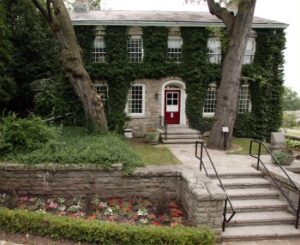
Among the interesting sites to visit along this trail is the Mackenzie Printery in Queenston, home to the Louis Roy press, the oldest wooden press in Canada, and one of only seven left in the world today. It was used to print Ontario’s first newspaper, The Upper Canada Gazette, as well as the 1793 Act Against Slavery, which prevented further introduction of enslaved people into Upper Canada and gradually allowed for the abolition of slavery.
A little further down the Parkway in Niagara-on-the-Lake, Navy Hall is a collection of buildings that served as the first seat of government for the Executive Council of Upper Canada, where John Graves Simcoe took the first legislative steps in the Act Against Slavery in 1793.
Situated at Regent and Johnson in Niagara-on-the-Lake, the Voices of Freedom Park commemorates the silenced and forgotten stories of people of African descent, whose sacrifices, labour, skills and talents contributed to the development of our town.
Ambassadors of the Past
You might be delighted to learn that some STAY Niagara-on-the-Lake member properties claim a direct link to colourful, historical figures from the past, some of whom are rumoured to roam their halls. However, we’ll keep those tales under wraps for a more appropriate time.
Many of our short-term rental property owners in Niagara-on-the-Lake are born storytellers who have made it their business to study the history of the Niagara Region and are happy to share their version(s) with anyone who will listen. So, ask away. You never know what history lesson you might uncover at the breakfast table or over a glass of wine.
History comes alive in Niagara. Isn’t it time you created a little history of your own for your travel albums?
Comin’ Up
It’s never too early to plan your trip to Niagara-on-the-Lake. Here’s a sampling of what’s to come:
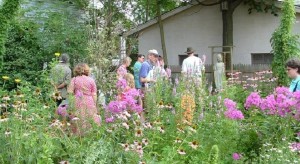
April 29 – Queens of the Vineyard at Caroline Cellars
May Weekends – Sip & Sizzle at various Niagara-on-the-Lake wineries
May 6 – TD Niagara Jazz Festival Spring 2023 Fundraising Event at The Hare Wine Co.
June 9 – White Effect Dinner at Peller Estates Winery
June 9 – September 15 – Summer Concert Series at Jackson-Triggs Winery Estate
June 17 & 18 – Juried Art Show at the Riverbank Art Museum
June 24 – Shaw Guild Garden Tour
July 1-3 – Artistry by the Lake
July 8 – Cherry Festival
August 12 – Peach Festival
August 12 – Sip, Savour & Stroll
August 13 – Shades of Summer Dinner





